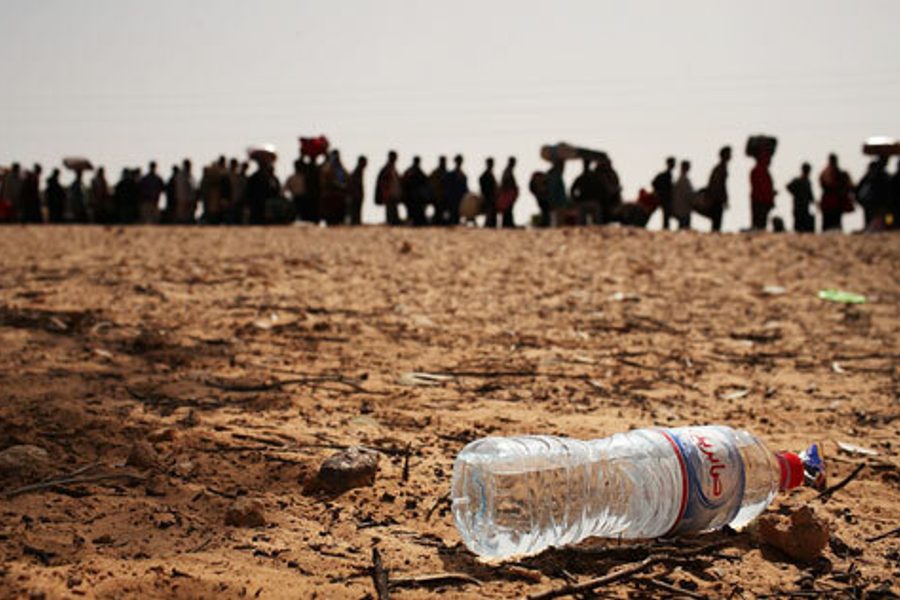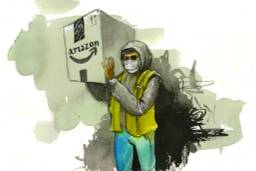
Over the past several weeks, the images emerging from the Middle East and North Africa have shocked and awed Western audiences, who had never seen, or bothered to notice, the massive potential of people power to challenge the rule of ossified dictators.
But the protest movements across the region have also shed light on less glorious struggles that pervade stratified Arab societies. If the young protesters represent the rise of civil society forces, the imported migrant laborers caught in the crossfire reflect the often-hidden economic and ethnic dimensions to the region’s power struggles.
On the besieged borders of Libya and in the ghettoized neighborhoods of Bahrain, migrants have found themselves in the peculiar position of being refugees from countries that were always alien to them. As the fighting escalated in Libya last week, the aid organization BRAC reported on migrants desperate to flee the country:
Nearly 70,000 Bangladeshi nationals were residing in Libya as migrant workers when violence erupted last month. As the conflict intensified, thousands fled to neighboring countries, where they face congested borders and overcrowded refugee camps and airports. Thus far, only 20,000 migrants have been able to return to Bangladesh – most of them heavily in debt and with no ready means of earning a living.
After leaving his workplace in the western Libyan town of Zawiyah, 28 year-old Bangladeshi migrant steelworker Mohammed Nienn joined mounting crowds at the Tunisian border at a displaced persons camp known as Choucha. Having languished for over a week in hopes of catching a flight out, he told the UN news service:
”My family tells me to get home as quickly as possible… But it’s not as simple as that. There are so many Bangladeshis here. The wait to go to the airport is quite long.”
Mohamed, a Somali from Mogadishu, spoke to the constant state of dispossession that follows refugees who go from one warzone to the next:
Every day I watch people board buses to the airport….But I’m not envious; their situation is just very different to mine. Even if I was offered the chance to go back to Somalia, I wouldn’t want to anyway. I’m just waiting to find out where I will end up.
International authorities counted some 17,000 refugees at Choucha, “10,000 from Bangladesh and the remaining 7,000 mostly from sub-Saharan African countries.” Repatriation efforts have varied widely, with some countries coordinating efforts to bring nationals home, while others have no home to return to — as in the case of Somalis and Palestinians who settled in Libya when it was relatively safe.
The plight of migrants is just one facet of the humanitarian crisis, but they embody the challenges to advancing a revolution in the face of social polarization and cultural dissonance. Even within Choucha, Bangladeshi and African refugees began to self-segregate as different groups struggled to make the most of tight supplies and food rations.
In Bahrain, where protests have been viciously crushed by government and Saudi forces, the country’s oil wealth is filtered along sectarian and class lines.. At the base of the stratified social structure are Bangladeshi immigrants, working in low-wage sectors like construction. According to Mother Jones, the tiny country is tightly parceled: “Sunni Muslims, westerners, Shiite Muslims, and South Asian migrant workers (who are not citizens but constitute almost half of Bahrain’s population) generally live in separate neighborhoods.”
Migrant workers are among the most vulnerable in the current political turbulence. Indeed, long before the protests the human rights situation for migrants in Bahrain was already dire, in some ways anticipating the terror the monarch has now unleashed on its own citizenry.
For all the promise of democratic change washing over Arab countries, underlying social rifts have ruptured – a telling reminder that even a rebellion from the “right side of history” can betray regressive views that often stew under the grip of dictatorship.
Black Africans in Libya (as opposed to ethnic Arabs), who have long suffered unequal treatment as migrants, have reportedly been brutally targeted on the suspicion that they are foreign mercenaries hired by Gaddafi to suppress protests.
Black Agenda Report commentator Glen Ford rounded up reports on racial violence in Libya, and drew a sobering reflection on the emergent “Arab re-awakening”:
In the turmoil, what is also re-awakened – or never really dormant – is a “problematic” form of anti-black racism that appears, at least in some parts of the North African Maghreb, endemic and woven into the fabric of Arab nationalism.
The (re)emergence of Arab nationalism nevertheless represents a catastrophe for U.S. imperialism, which abhors all nationalisms except its own as it seeks to bend every national aspiration to the will of capital and its war machinery. However, the racism that is clearly manifest in Libya’s current dynamic is also a huge impediment to pan-African solidarity, inviting new waves of imperial mischief on the continent. On that score, we should have no illusions.
In reality, the migrants who take the dirtiest jobs in these oil-rich nations have a lot in common with the revolutionaries risking everything for emancipation. As Mohamed the Somali refugee said, they’re all waiting to find out where they will end up. A parallel form of dislocation stirred native-born Bahrainis and Libyans to rise up and reclaim their country from tyranny.
The rebellions don’t merely call for regime change or constitutional reform; people seek the sovereignty and dignity that have long been denied to them. Though frequently ignored in nationalist political clashes, migrants share in this struggle too, whether or not they see themselves as part of the civil conflict. They’re pitted against the dictatorship of global capital that subsumed their repressive host countries. Both migrants and citizens alike have endured wholesale disenfranchisement — the disempowerment that was first expressed by the defining act of protest that touched off the “Arab spring”: the self-annihilation of a desperate young worker in Tunis.
Some migrants are raising their voices as stakeholders in political conflicts as well. A group of Filipino migrant workers with the advocacy group Migrante-Middle East has denounced the air-strikes on Libya as “done in bad faith just to pursue their own self-serving geopolitical and economic agenda in Libya and the entire Middle East and North African region.”
Refugees from America’s former colony should know: this latest tide of displacement is just more proof that in an age of fluid borders and global capital, real revolution is anchored in the dignity of all workers, wherever they’ve come from, and wherever they’re going.
Michelle Chen is a contributing writer at In These Times and The Nation, a contributing editor at Dissent and a co-producer of the “Belabored” podcast. She studies history at the CUNY Graduate Center. She tweets at @meeshellchen.








